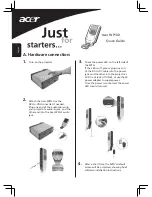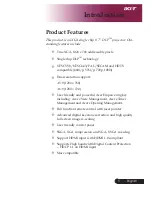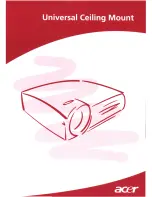
INITIAL OPERATION
CLEAN ALL FILM-BEARING SURFACES BEFORE EACH THREADING OPERATION. Check
all sprocket teeth for hooks or burrs; replace if required. Keep all pad rollers clean and operating freely.
Make certain the turret is set to the correct lens and aperture for the desired screen format. FLAT format is
generally used for initial setup of the projection system.
The Film Trap Tension Knob is located at the top of the film trap, and is graduated from “minus” (-) to
“plus” (+). Rotate this knob counterclockwise to its stop. The “minus” (-) setting indicates minimum trap
tension. Thread film into the projector, ignite the lamp, and project a picture to the screen. Use of RP-40 test
film is highly desirable for this stage of machine set-up. This test film may be purchased directly from the
Society of Motion Picture and Television Engineers:
SMPTE Test Film Department
595 West Hartsdale Avenue
White Plains, New York 10607
or
www.smpte.org
Order: 35 PA-50 (50 ft.) or 35 PA-200 (200 ft.)
Install the lenses and set focus as detailed in the preceding INSTALLATION section. File the apertures
to fit screen or masking parameters.
If the projected picture is unsteady, rotate the film trap tension knob clockwise one step at a time, while
the film is running. Always adjust for the
minimum
tension
required to project a steady picture. Excessive
tension not only increases wear on projector parts, but in extreme cases may cause torn perforations and
film breakage.
Check the projected picture for travel ghost. “Travel Ghost” is the term commonly applied to vertical
streaking of lighter areas against a darker area, and is particularly noticeable during opening or closing titles
and credits. If ghosting is apparent, rotate the shutter adjustment knob on the top of the projector until the
ghosting disappears. If the ghost cannot be eliminated by means of this knob, see “Shutter Timing” in the
ADJUSTMENTS AND REPLACEMENTS section of this manual.
The rotation travel of the lens turret is limited by the indexing stop pin mounted to the outer ring of the
turret. The automated turret on the Apogee includes a solenoid which pulls the pin when the turret is in motion.
A compression spring seats the pin when the turret is at rest. When first energized, the autoturret will
automatically index to FLAT mode, if not already in FLAT. The proximity switch on the turret ring will sense
the cueing magnet mounted to the index stop bracket and set the correct picture aperture: one magnet mounted
inboard = FLAT, one magnet mounted outboard = SCOPE, two magnets = SPECIAL (third lens).
In the event of a turret or aperture motor failure, the automatic turret can be operated manually until a
replacement motor is obtained. It is advisable to de-energize the turret control until the replacement motor is
installed. The dual aperture plate can be pushed in or pulled out manually to set the correct format.
17
Содержание APOGEE
Страница 17: ...12 Figure B is in optimal alignment ...
Страница 35: ...30 FILM TRAP Assembly No 52 00223 ...
Страница 39: ...34 APOGEE LENS TURRET Assembly No 52 00279 ...
Страница 45: ...CONTROL CABINET Wiring Diagram 40 ...
Страница 54: ...OIL PUMP ASSEMBLY 49 ...
Страница 63: ......
















































